Slava
The Slava (Serbian Cyrillic: слава, lit. 'celebration', pronounced [ˈslâʋa]) is a Serbian Orthodox Christian tradition of the ritual glorification of one's family's patron saint. The family celebrates the Slava annually on the saint's feast day. In November 2014 it was inscribed in UNESCO Intangible Cultural Heritage Lists.
| Slava | |
|---|---|
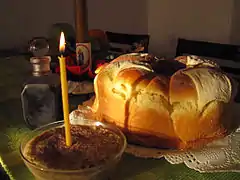 Slava prepared for the veneration of John the Baptist | |
| Observed by | Serbian Orthodox Christians |
| Significance | Veneration of the family's patron saint |
| Observances | Church services, family and other social gatherings |
| Part of a series of articles on |
| Serbs |
|---|
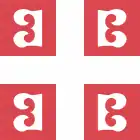 |
Overview
The Slava is the family's annual ceremony and veneration of their patron saint, a social event in which the family is together at the house of the patriarch. Also, the friends of the family come to the patriarch's house, usually without a prior invitation (There's an old Serbian proverb about Slavas - "На славу се не зове" which literally means "One does not invite people on Slava"). The family saint is inherited from the patriarch (head of the household) – from father to son, while women adopt the patron saint of their husbands upon marriage. As several patron saints are venerated twice a year, the main day is the Slava, while the secondary one is called preslava. Some families may celebrate another patron saint in the case when the wife is the only left of her kin, in respect to her family. In cases where the daughter's husband has joined (traditional) household of the parents-in-law ("prizet"/"domazet" = "by-son-in-law"/"son-in-law-in-the-home"), the wife's father's slava is celebrated as the main one (when guests are expected and/or invited) and the son-in-law's only as an additional lesser one (when just a festive meal is prepared for the family and no manual work is carried out, but no guests are expected).
The tradition is an important ethnic marker of Serbian identity.[1] The slogan: "Где је слава, ту је Србин" ("Where there is a Slava, there is a Serb") was raised as a Serbian national identifier by Miloš Milojević after his travel to Kosovo and Metohija in 1871–1877.[1] Serbs usually regard the Slava as their most significant and most solemn feast day.[2] The tradition is also very well preserved among the Serbs worldwide.[3]
Besides present day Serbia, Slava is also common in some of the territories where Serbian medieval state extended its rule and cultural influence, but not only there. Similar or identical traditions are found in different countries on the Balkans and not only among the Serbs,[4] but also among Montenegrins, Macedonians, Catholics from Boka Kotorska, Konavle, Southern Herzegovina, Bosansko Grahovo, Janjevci, Christians in Northern Albania, and Muslims among Gorani and some Bosniaks in Bosnia and Sandžak. A similar tradition is found in Western Bulgaria, but also among some Vlachs and Aromanians.[1]
Origin
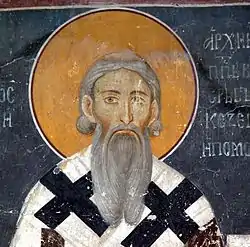
Some Serbian historians consider that records of slava amongst Serbs can be traced back to 1018.[5]
The tradition has its origin in the Medieval Serbia, connected to Saint Sava, the first Archbishop of the Serbs. There are indications that the institution of the slava dates from Saint Sava, that "in his understanding and tactful approach to Serbian folk religion", he "seems to have found a compromise formula satisfactory to both his people's tradition and the requirements of Byzantine theology".[6] The slava is a reinterpretation of a pagan rite:[7] the ancestor-protector became a Christian saint,[8] frequently St. Nicholas,[7] with the pagan rite being reduced of many religious elements and frequent ceremonies and becoming a social event with the annual meeting of the family and friends.[8][9]
At the same time, there is an ongoing discussion in the Serbian historical and ethnological literature about the origin of the Slava, which has not yet been completed. According to some Serbian researchers, the thesis of how Slava is Serbian ethnic identification marker is simply patriotic delusion of the romantic and patriotic citizenry.[10]
Modern history
The increased effective geographic mobility brought about by the post World War II urbanization of a previously highly agrarian society, combined with the suppression of Serbian Orthodox traditions under the Communist rule, has made some aspects of the custom more relaxed. In particular, in the second half of the 20th century it became common to see traditional patriarchal families separated by great distances, so by necessity Slava came to occasionally be celebrated at more than one place by members of the same family.
While the Slava kept something of a grassroots underground popularity during the Communist period, the post-Communist revival of Serbian Orthodox traditions has brought it a resurgence. It is recognized as a distinctly (if not quite exclusively) Serbian custom, and today it is quite common for nonobservant Christians or even atheists to celebrate it in one form or another, as a hereditary family holiday and a mark of ethnocultural identification.
In November 2014 it was inscribed in the UNESCO Intangible Cultural Heritage Lists.
The custom is also helpful in genealogical studies as an indicator in kinship relations between families, tracing one's family to a specific region, etc.
Celebration
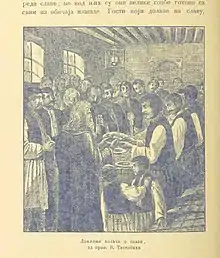
Где је слава, ту је Србин / Gde je slava, tu je Srbin ("Where there is a Slava, there is a Serb")
The ritual foods that are prepared for the feast are the slavski kolač (or simply kolač) = a ritual bread, and koljivo (or žito), a dish of minced boiled wheat, sweetened and sometimes mixed with chopped walnuts. The top of the kolač is adorned with the Christian cross, the peace dove, and other symbols. The koljivo is a symbol of the Resurrection of Christ (cf. "if the grain does not die..." in the Gospel) and partaken in memory of the dead (deceased family members).
The rest of the feast consists of a meal, the contents of which depends on whether or not the celebration falls in a period of fasting. During a fast (post), the meal would not contain any meat other than fish or other seafood, and would be highly unlikely to contain eggs or dairy products. Outside of a fasting period, these restrictions would not apply (mrsno). Thus, colloquially, slavas can be referred to as posna or mrsna. Appropriately-made sweets are consumed, as well.
The family attends church services and partakes in Holy Communion on the feast day. Following the service, traditionally, the parish priest is received in the family's home or the family brings the slavski kolač to the church. The parish priest performs a small service which entails venerating the patron saint's memory, blessing the kolač and koljivo, as well as lighting the "slava candle". Though not necessary, it is common for the priest to bless the house and perform a small memorial service for dead relatives.
The most common feast days are St. Nicholas (Nikoljdan, 19 December), St. George (Đurđevdan, 6 May), St. John the Baptist (Jovanjdan, 20 January), St. Demetrius (Mitrovdan, 8 November), St. Michael (Aranđelovdan, 21 November) and St. Sava (Savindan, 27 January). Dates given are according to the Gregorian calendar. The Serbian Orthodox Church uses the Julian calendar.
Many Serbian communities (villages, cities, organizations, political parties, institutions, companies, professions) also celebrate their patron saint. For example, the city of Belgrade celebrates the Ascension of Jesus Christ as its patronal feast.
 Slavski kolač, a type of bread that has an important role in the celebration of the Slava.
Slavski kolač, a type of bread that has an important role in the celebration of the Slava.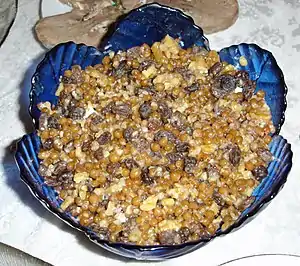 Koljivo
Koljivo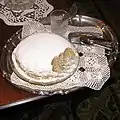 Žito
Žito
 Slava candle
Slava candle
See also
Annotations
- Krsna slava (Крсна слава, "christened Slava") and Krsno ime (Крсно име, "christened name")
References
- Petko Hristov, The Use of Holidays for Propaganda Purposes: The "Serbian" Slava and/or the "Bulgarian" Săbor in Ethnologia Balkanica. LIT Verlag Münster. pp. 69–80. GGKEY:ES2RY3RRUDS.
- Celia Jaes Falicov (1991). Family Transitions: Continuity and Change Over the Life Cycle. New York City: Guilford Press. p. 219. ISBN 978-0-89862-484-7.
- Michael B. Petrovich; Joel Halpern (1980). "Serbs". In Stephan Thernstrom; Ann Orlov; Oscar Handlin (eds.). Harvard Encyclopedia of American Ethnic Groups (2nd ed.). Harvard University Press. p. 925. ISBN 978-0-674-37512-3.
- Jovan F. Trifunovski. "Породична слава и сличне славе у охридско-струшкој области" (PDF). Bulletin of the Ethnografical Institute SASA, vol XLV (in Serbian).
- Nikola F., Paković (2015). "Slava ili krsno ime kod Srba". Glasnik Etnografskog instituta SANU. LXIII: 128.
- Serb World. 3–4. Neven Publishing Corporation. 1982. p. 5.
- A. P. Vlasto (1970). The Entry of the Slavs Into Christendom: An Introduction to the Medieval History of the Slavs. CUP Archive. pp. 223–. ISBN 978-0-521-07459-9.
- The folk arts of Yugoslavia: papers presented at a symposium, Pittsburgh, Pennsylvania, March 1977. Duquesne University Tamburitzans Institute of Folk Arts. 1976. p. 41.
- Folk Culture: Folk culture & the great tradition. Institute of Oriental and Orissan Studies. 1983. p. 113.
- Petko Hristov, The Use of Holidays for Propaganda Purposes: The “Serbian” Slava and/or the “Bulgarian” Săbor Petko Hristov, Ethnologia Balkanica, LIT Verlag, 2002, Issue No: 06, p 79: And here we completely agree to the conclusion of Milenko Filipović that the thesis regarding the slava, služba or the krastno ime were a purely Serbian feature, was “…a delusion of the romantic and patriotic citizenry and those from among those circles that were writers”, a delusion, of which …je samo srpstvo imalo više štete, nego koristi” [“The Serbian people have had more losses than benefits/advantages”]. (Filipović M., 1985; 152). Although here and there in scholarly publications, and particularly in popular books, even in the formal publications of the Serbian Eastern Orthodox Church, some of these romantic delusions about the slava as a Serbian ethnic identification marker are repeated, the serious scholars giving interpretation to the slava M.Filipović, V.Čajkanović, P.Vlahović, N.Pantelić, S.Zečević, D.Bandić, point out mostly the agrarian and integrative functions of the set of rites and rituals, united under the name of slava, and its tie-up with the cult for the forefathers.
Further reading
- Hrizostom Vojinović (1963). Srpska slava ili krsno ime. Mala religiozna biblioteka 23.
- Jovan Todorovich (1978). Serbian Patron Saint (Krsna Slava).
- Dimitrije Kiki Popadic (1999). Krsna Slava Among the Serbs: A Case for Contextualized Reinterpretation. Fuller Theological Seminary.
- Љубисав Милосављевић, ed. (2005). Домаћине, срећна ти крсна слава. ИТТ Национал. ISBN 978-86-85233-37-1.
- Milan T. Vuković (1972). Narodni običaji, verovanja i poslovice kod Srba.
- Krsto Milovanović (1997). Slave. Narodno delo. ISBN 9788671191197.
- Mile Nedeljković (1991). Slava u Srba. Vuk Karadžić. ISBN 9788630703256.
- Bratislav Grubačić; Momir Tomić (1988). Srpske slave: narodni običaji i verovanja, narodne pesme i zdravice, slavska jela i pića. Litera. ISBN 9788674670026.
- Dimitrije M. Kalezić (2000). Krsne slave u Srba. Narodna knjiga–Alfa.
- Влаховић, П. (1998). Крсна слава и њена улога у породичном и друштвеном животу код Срба. В: Етно-културолошки зборник. Књ. ІV, Сврљиг, 23–32.
- Чајкановић, Веселин. "Мит и религија у Срба." Српска књижевна задруга 443 (1973): 128–153.
- Vasić, M. (1985). Slava-Krsno ime. u: O krsnom imenu-zbornik. Beograd: Prosveta, 218–219.
- Radenković, L. R. (2013). Slava: The Serb family feast. Zbornik Matice srpske za slavistiku, (84), 9-23.
- Pavković, Nikola F. (2015). "The Slava or Patron Saint's Day among the Serbs" (PDF). Glasnik Etnografskog instituta SANU. 63 (1): 123–145. doi:10.2298/GEI1501123P.
External links
| Wikimedia Commons has media related to Slava. |
| Look up slava in Wiktionary, the free dictionary. |
- Ranković, Ljubomir. "Krsna Slava" (in Serbian). Svetoslavlje. Archived from the original on 2015-05-07.
- "Serb families honour their saints with Slava celebrations". BBC. 3 March 2013.
- Intergovernmental Committee for the Safeguarding of the Intangible Cultural Heritage (November 2014). "Slava". Nomination file no. 01010 for Inscription on the Representative List of the Intangible Cultural Heritage of Humanity in 2014. Paris, France: UNESCO.